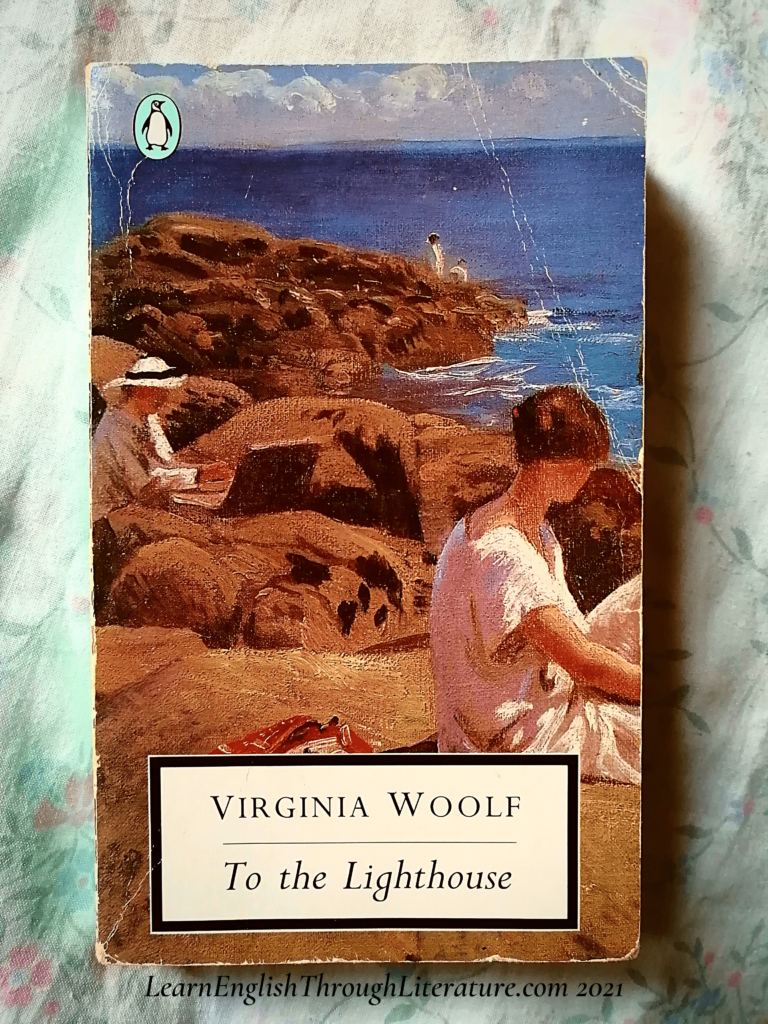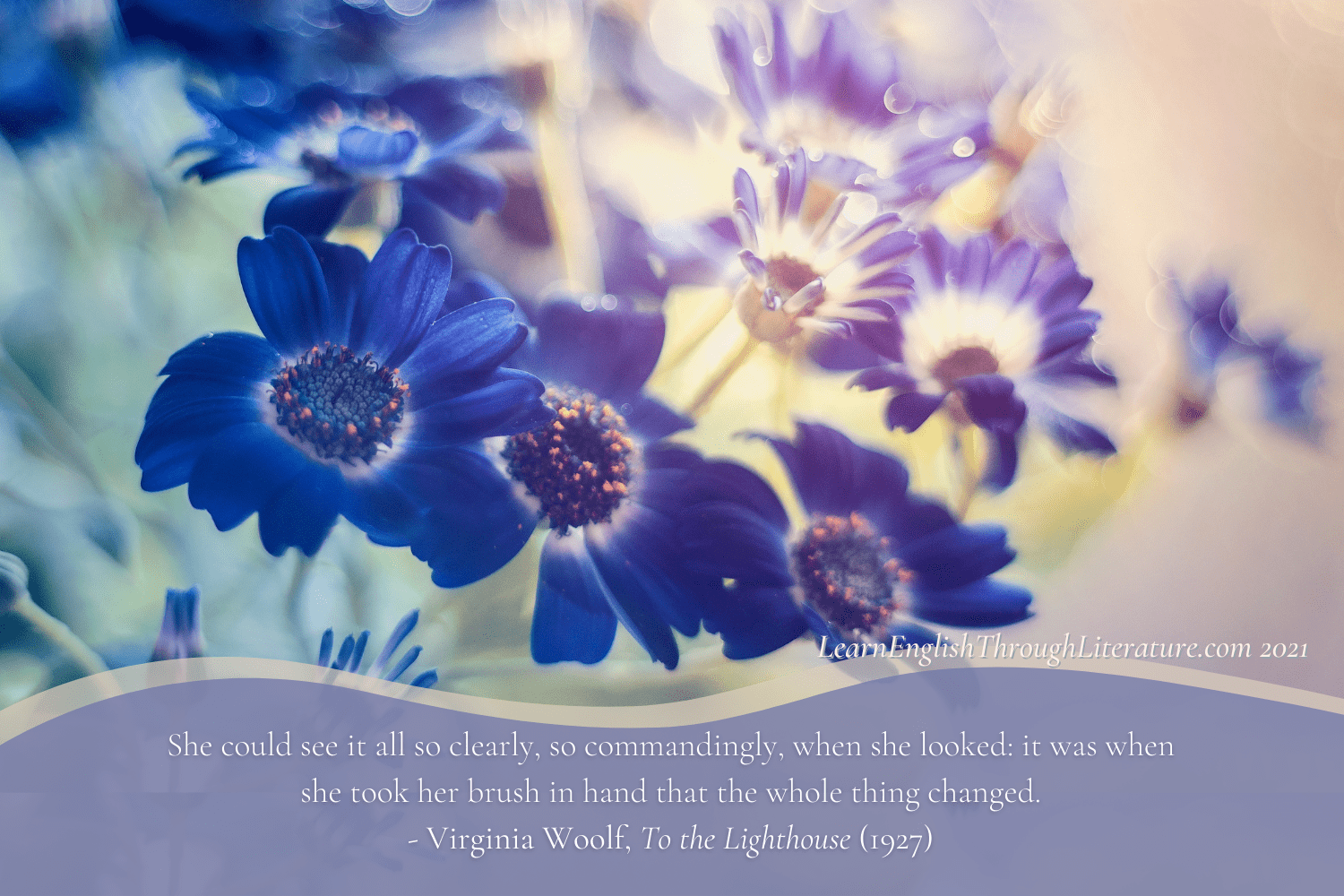A few days ago, I mentioned how I enjoy painting whenever I have the opportunity. 🎨
To be honest, there was a time when I thought I would pursue this interest more professionally. But for now, I just enjoy it as a pastime – that said, the urge to perfect paintings or drawings is still there!
Do you have a hobby or pastime that you wish you could develop more? 🤔
Have you ever thought of pursuing it as a career? 🧐
In today’s reading, I wanted to look at an insightful passage from Virginia Woolf on that topic. One of her most beloved works (and my favourite Woolf book), To The Lighthouse (1927), tells the story of the Ramsay family at their holiday home in Scotland around the end of the nineteenth century (c. the 1890s). Being a hospitable couple, the Ramsays have invited different friends to stay with them and their children.
One of these friends is Lily Briscoe, a young woman who lives with her father in London and ‘keeps house’ for him (an old-fashioned expression meaning that she manages the housekeeping, etc). She loves to paint and often dreams of perfecting her skill so that she can truly become an accomplished artist and enjoy the respect and independence it would bring.
On the other hand, Lily is impressed by the Ramsays (especially Mrs Ramsay), by their family life and values, and deeply longs to be able to marry and have a family of her own. These two great desires of her life cause her to feel some tension because she feels that she cannot have both, and Virginia Woolf captures it in this wonderfully evocative (bringing strong feelings, images, and memories to mind) passage below.
🔎 Join me for a line-by-line analysis and reflection on this portion of text from Virginia Woolf’s classic.

…
📘 A passage from TO THE LIGHTHOUSE (1927)
by Virginia Woolf
✒️ We start off with a description of Lily’s challenges when it comes to capturing the look or impression of an object in a painting.
📘 She could see it all so clearly, so commandingly, when she looked: it was when she took her brush in hand that the whole thing changed. It was in that moment’s flight between the picture and her canvas that the demons set on her who often brought her to the verge of tears and made this passage from conception to work as dreadful as any down a dark passage for a child. Such she often felt herself—struggling against terrific odds to maintain her courage; to say: “But this is what I see; this is what I see,” and so to clasp some miserable remnant of her vision to her breast, which a thousand forces did their best to pluck from her.
– Virginia Woolf, ‘To The Lighthouse’
✒️ These three sentences describe poor Lily’s struggles as she tries to paint what she sees. The ‘demons’ described here refer to all those evil thoughts and feelings, all the doubts that Lily faces every time she ‘took her brush in hand’. This sometimes causes her to lose her confidence in her ability to paint anything; she often feels like she is on the ‘verge’ (edge) of bursting into tears. The narrator describes this process ‘from conception’ (the point in which the idea begins) ‘to work’ (the final finished painting) as a ‘passage’.
‘Passage’. This word gives us the sense of a journey, and Woolf enforces it (makes it stronger) by describing it as similar to going down ‘a dark passage for a child’. Earlier in the paragraph, she has described the short time between having an idea and actually expressing it in painting as ‘that moment’s flight’, hinting that sometimes it is just a matter of seconds before Lily loses the ability to express the idea.
👉 A quick question for you: Have you ever felt like Lily Briscoe – somewhat confused or frustrated – when trying to express yourself in another language (English for example, especially if it isn’t your mother tongue)? It happens sometimes! It is normal to feel like this when trying to learn and express something new, since it is part of the process of stretching and developing our abilities!
But back to Lily …
Lily struggles ‘against terrific odds’ (mainly her fears, doubts, and lack of confidence) to paint ‘what I see’. It affects her ability to believe in herself, and she feels as though her ‘vision’ or dream is being torn away from (‘pluck’) her by ‘a thousand forces’ who are against her success.
📘 And it was then too, in that chill and windy way, as she began to paint, that there forced themselves upon her other things, her own inadequacy, her insignificance, keeping house for her father off the Brompton Road, and had much ado to control her impulse to fling herself (thank Heaven she had always resisted so far) at Mrs. Ramsay’s knee and say to her—but what could one say to her? “I’m in love with you?” No, that was not true. “I’m in love with this all,” waving her hand at the hedge, at the house, at the children. It was absurd, it was impossible.
– Virginia Woolf, ‘To The Lighthouse’
This paragraph begins with a long opening sentence, and Woolf’s punctuation can sometimes make them even more challenging to read!
📝 By the way, Woolf was often intentional about her punctuation; her purpose was to capture the long-winded, wandering style of our thinking processes. This is sometimes called ‘stream of consciousness’ writing – many early 20th-century writers like Woolf, James Joyce, and Samuel Beckett experimented with this style.
I will introduce my own punctuation in this sentence just to clarify its meaning for you here:
And it was then too (in that chill and windy way, as she began to paint), that there forced themselves upon her other things: her own inadequacy, her insignificance, keeping house for her father off the Brompton Road, etc ...
She has been painting her picture in a ‘chill and windy way’ or part of the garden. This physical coldness reminds her of the psychological coldness she feels about herself: ‘her own inadequacy, her insignificance, keeping house for her father off the Brompton Road’ (a comfortable, settled neighbourhood in London, at some distance from the excitement of the city centre).
Furthermore, Lily feels a strong attraction for the kind of life that Mrs Ramsay lives at the heart of her family. In fact, she describes it as being ‘in love with all this’. But the feeling, though strong, is very vague and uncertain. She feels half-ashamed of it, and ends up judging it as ‘absurd, … impossible’. Lily is certain at this moment that she will never marry or have children like Mrs Ramsay and so should not long (desire deeply) so strongly for something that is so improbable (not likely to happen).
📘 So now she laid her brushes neatly in the box, side by side, and said to William Bankes:
“It suddenly gets cold. The sun seems to give less heat,” she said, looking about her, for it was bright enough, the grass still a soft deep green, the house starred in its greenery with purple passion flowers, and rooks dropping cool cries from the high blue. But something moved, flashed, turned a silver wing in the air. It was September after all, the middle of September, and past six in the evening. So off they strolled down the garden in the usual direction, past the tennis lawn, past the pampas grass, to that break in the thick hedge, guarded by red hot pokers like brasiers of clear burning coal, between which the blue waters of the bay looked bluer than ever.
– Virginia Woolf, ‘To The Lighthouse’
This last passage begins with Lily interrupting her own thoughts with a few spoken words directed to William Bankes. Bankes is another friend of the Ramsay family and has met Lily while walking about in the garden.
✍️ The speech here – simple as it is – also has an effect on the readers.
It is as if the spell of the internal life (thoughts, feelings, motivations, etc.) is suddenly broken and we are brought down to reality in one go: ‘it was bright enough … it was September after all …’ (emphases my own here). These following descriptions of the colours of the grass, flowers, and sky all ground us (cause us to feel settled again) in the present moment, in what is actually happening around Lily as much as within her.
The paragraph draws to a close with the two friends walking (‘strolled’) down the garden towards the sea – ‘the blue waters of the bay looked bluer than ever’. Some new words here include greenery (the green or fresh quality of plants, etc.), rooks (a kind of black garden bird that is common in Britain and Ireland), hedge (a long barrier made of bushes or shrubs, usually found as a boundary marker between different fields), pampas grass (a feathery and ornamental garden grass), red hot pokers (a kind of flower with a red flower atop a straight stalk), and brasiers (iron containers used to burn charcoal or other solid fuel for cooking, heating, or cultural rites).
📝 One last observation: notice how Virginia Woolf uses descriptions that remind us of birds and flying.
She writes of the quickness of ‘that moment’s flight’, of the ‘rooks dropping cool cries from the high blue’, and then she introduces a whole new sentence: 📘 ‘But something moved, flashed, turned a silver wing in the air.’ This last line captures the feeling of a sudden chill in the air that we often feel on a September evening (in the northern hemisphere); and Virginia Woolf makes use of her bird-like description to observe that that same chilling moment has ‘a silver wing’.
✍️ This last line is a perfect example of Woolf’s gift for imagery and capturing moments when there is a sudden change in the environment, externally or internally.
…
What a remarkable passage that is! I hope you have enjoyed reading through it as much as I have enjoyed parsing it (breaking it into smaller sections as to analyse it) and reflecting on it.
It also offers you a small sample of Virginia Woolf’s writing and may show you whether you might like to read more of her works eventually. I personally admire her style very much: although it is a bit complex at times, it is so full of deep insights on how human minds and hearts work in everyday moments.
Till next time, happy reading! 📚




